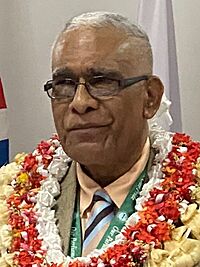President of Fiji facts for kids
Quick facts for kids President of Fiji |
|
|---|---|

|
|
| Style | His Excellency |
| Residence | State House |
| Appointer | Parliament of Fiji |
| Term length | Three years,
renewable once
|
| Constituting instrument | Constitution of Fiji (2013) |
| Precursor | Monarchy of Fiji |
| Inaugural holder | Penaia Ganilau |
| Formation | 5 December 1987 |
| Deputy | Vice-President of Fiji (1990–2013) Chief Justice of Fiji (2013–present) |
| Salary | FJ$130,000 annually |
The President of Fiji is the country's head of state. This means the president is the official representative of the Republic of Fiji. The Parliament chooses the president for a three-year term. This term can be renewed once.
The president's job is mostly ceremonial. This means they act as a symbol for the nation. However, the president also has important special powers for times of crisis. The president is also the top leader of the Republic of Fiji Military Forces.
Contents
History of the Office
The role of president was created after two military takeovers in 1987. These events led to Fiji becoming a republic on October 7, 1987. This meant Fiji no longer had a king or queen as its head of state.
First President and Early Years
Major-General Sitiveni Rabuka led the military takeovers. He formed a temporary military government. On December 5, 1987, he appointed Ratu Sir Penaia Ganilau as the first president. Ratu Sir Penaia Ganilau had been the last governor-general, who represented the Queen.
Changes in the 2000s
In 2000, there was another political change. This was led by George Speight. President Ratu Sir Kamisese Mara stepped down on May 29, 2000. He did not want to cancel the country's main rules, the Constitution.
Commodore Frank Bainimarama then took charge of a temporary military government. Later, Ratu Josefa Iloilo became president on July 13, 2000.
In December 2006, the military again took control of the government. Commodore Bainimarama first said he was acting president temporarily. He later insisted he was the president. However, Ratu Josefa Iloilo was put back as president on January 4, 2007.
New Ways to Choose the President
In 2008, Bainimarama stated that the military would choose the president. This was because the Great Council of Chiefs, a traditional group of leaders, was suspended.
On July 28, 2009, President Iloilo announced he would leave office. Brigadier-General (Rtd) Ratu Epeli Nailatikau became acting president. He was sworn in as president on November 5, 2009.
In March 2012, the Great Council of Chiefs was officially ended. This meant a new way to choose the president was needed. The new Constitution, adopted in 2013, set out this new method.
Recent Presidents of Fiji
On October 12, 2015, the Parliament elected Major-General (Rtd) Jioji Konrote as president. He was sworn in on November 12, 2015. Konrote was re-elected on August 31, 2018.
On October 22, 2021, the Parliament elected Ratu Wiliame Katonivere as president. He was sworn in on November 12, 2021.
The current president, Naiqama Lalabalavu, took office on November 12, 2024.
List of Presidents
See also


